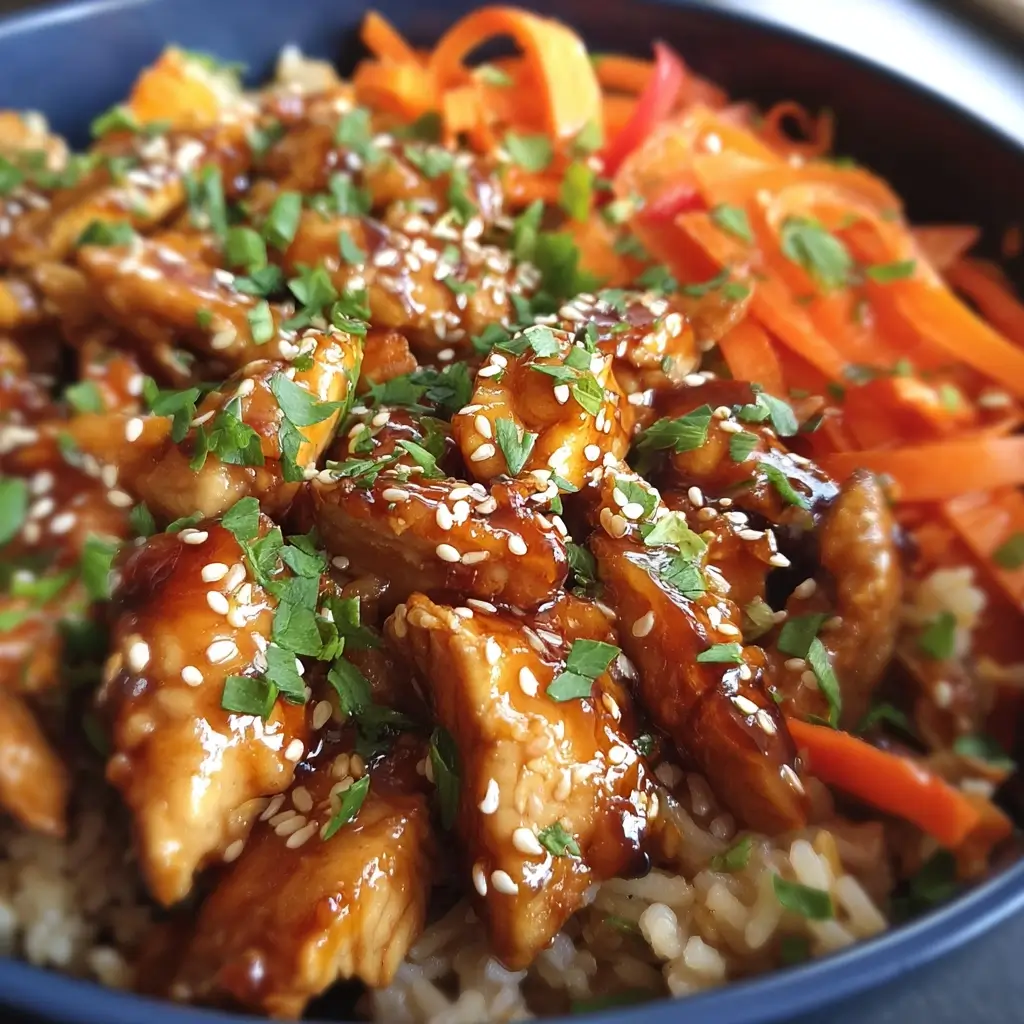Of all the dishes in my weekly rotation, this Chicken and Carrot Teriyaki Rice holds a special place in my heart and on my family’s dinner table. I remember the first time I made it, I was scrambling for a weeknight meal that was both quick and something my kids wouldn’t push around their plates. The skepticism on their faces as I started chopping the carrots was palpable. But then, something magical happened. The kitchen began to fill with the most incredible aroma—a sweet, savory, garlicky scent that had everyone peeking into the kitchen. The vibrant orange of the carrots against the glossy, dark teriyaki sauce and fluffy white rice was a feast for the eyes before it even hit the plates. The moment of truth came at the dinner table. Silence. Not the awkward kind, but the focused, “I’m-too-busy-enjoying-this-to-talk” kind. My youngest, a notoriously picky eater, asked for seconds. That was it. That was the moment this recipe went from a one-time experiment to a bona fide family classic. It’s more than just a meal; it’s a guaranteed win. It’s the dish I make when I need a foolproof dinner that brings everyone together, fills our home with a comforting aroma, and leaves everyone satisfied and happy. It’s my secret weapon for turning a chaotic Tuesday into a delicious, memorable family dinner.
Ingredients
Here is the complete list of what you’ll need to create this incredibly flavorful dish. Each component is chosen specifically to build layers of sweet, savory, and umami flavors for a truly restaurant-quality experience at home.
For the Homemade Teriyaki Sauce:
- 1/2 cup Low-Sodium Soy Sauce: The savory, umami backbone of our sauce. Using low-sodium gives you better control over the saltiness.
- 1/4 cup Mirin: A sweet Japanese rice wine that adds a unique sweetness and glossy sheen to the sauce.
- 1/4 cup Water: Helps to balance the intensity of the other ingredients, creating the perfect sauce consistency.
- 3 Tablespoons Brown Sugar, Packed: Provides a deep, molasses-like sweetness that complements the soy sauce perfectly.
- 2 Tablespoons Sake (or Dry Sherry): Adds depth and complexity, helping to tenderize the chicken.
- 2 cloves Garlic, Minced: Aromatic and pungent, garlic is essential for a savory foundation.
- 1-inch piece of Ginger, Grated: Adds a warm, zesty spice that cuts through the richness of the sauce.
- 1 Tablespoon Cornstarch + 2 Tablespoons Cold Water: This is our slurry, used at the end to thicken the sauce to a perfect, glossy consistency that clings to every grain of rice and piece of chicken.
For the Chicken and Rice:
- 1.5 lbs Boneless, Skinless Chicken Thighs, cut into 1-inch cubes: Chicken thighs are preferred for their flavor and tenderness; they stay juicy even when cooked at high heat.
- 2 Tablespoons Vegetable Oil (or other neutral oil): For searing the chicken and sautéing the vegetables without adding a competing flavor.
- 1 large Yellow Onion, Diced: Provides a sweet and savory base layer of flavor when sautéed.
- 2 large Carrots, Shredded or Finely Diced: Adds natural sweetness, a vibrant color, and a healthy dose of vitamins. Shredding them helps them cook quickly and integrate beautifully with the rice.
- 1.5 cups Short-Grain White Rice (like Calrose or Sushi Rice), Rinsed: This type of rice is ideal as it becomes slightly sticky when cooked, perfect for soaking up the teriyaki sauce. Rinsing removes excess starch for a fluffier texture.
- 2 cups Chicken Broth (or Water): Using broth instead of water to cook the rice infuses it with an extra layer of savory flavor from the very beginning.
For Garnish (Optional but Recommended):
- 2 Green Onions, Thinly Sliced: Adds a fresh, mild onion bite and a pop of green color.
- 1 Tablespoon Toasted Sesame Seeds: Provides a nutty flavor and a delightful textural crunch.
- A drizzle of Toasted Sesame Oil: A finishing touch that adds an incredible nutty aroma.
Instructions
Follow these step-by-step instructions carefully to achieve the perfect balance of flavors and textures. The process is broken down into preparing the sauce, cooking the components, and bringing it all together for a stunning final dish.
Step 1: Prepare the Homemade Teriyaki Sauce
In a medium-sized bowl, combine the low-sodium soy sauce, mirin, water, brown sugar, and sake (or dry sherry). Whisk thoroughly until the brown sugar is completely dissolved. Add the minced garlic and grated ginger to the mixture and stir to combine. Set this sauce mixture aside for later. This allows the flavors of the garlic and ginger to infuse into the liquid, creating a more aromatic and flavorful sauce.
Step 2: Sear the Chicken to Perfection
Pat the cubed chicken thighs dry with a paper towel. This is a crucial step to ensure you get a beautiful golden-brown sear rather than just steaming the meat. Season the chicken lightly with salt and pepper. Heat the vegetable oil in a large, deep skillet or Dutch oven over medium-high heat. The oil should be shimmering but not smoking. Carefully add the chicken pieces to the hot pan in a single layer, being careful not to overcrowd it. You may need to do this in two batches. Cook the chicken for 3-4 minutes per side, until it’s golden brown and cooked through. The goal is to develop a nice crust, which adds immense flavor. Once cooked, remove the chicken from the skillet with a slotted spoon and set it aside on a plate.
Step 3: Sauté the Aromatics and Vegetables
In the same skillet, there should be some flavorful chicken drippings left. If the pan is too dry, add another teaspoon of oil. Reduce the heat to medium and add the diced yellow onion. Sauté for 3-4 minutes, stirring occasionally, until the onion has softened and become translucent. Next, add the shredded carrots to the skillet. Continue to cook for another 2-3 minutes, until the carrots have softened slightly but still retain a bit of their texture.
Step 4: Toast and Cook the Rice
Add the rinsed short-grain rice directly into the skillet with the onions and carrots. Stir continuously for about 1-2 minutes. This step is called “toasting” the rice. It coats each grain in the flavorful oil and drippings and gives the finished dish a slightly nutty, more complex flavor. Pour in the 2 cups of chicken broth (or water) and stir everything together, scraping up any browned bits from the bottom of the pan—this is where a lot of the flavor is.
Step 5: Simmer and Steam
Bring the liquid in the skillet to a gentle boil. Once it’s bubbling, reduce the heat to the lowest possible setting. Arrange the previously seared chicken pieces on top of the rice mixture. Place a tight-fitting lid on the skillet. Let it simmer for 15-18 minutes, or until the rice has absorbed all the liquid. It is very important that you do not lift the lid during this time, as that would release the steam needed to cook the rice properly.
Step 6: Thicken the Sauce and Combine
While the rice is simmering, prepare your cornstarch slurry. In a small bowl, whisk together the 1 tablespoon of cornstarch and 2 tablespoons of cold water until it’s completely smooth and free of lumps. After the rice has finished cooking, remove the skillet from the heat but keep the lid on. Let it rest for 10 minutes. This resting period is essential for allowing the rice to finish steaming, resulting in a perfectly fluffy texture.
After resting, remove the lid. Give the reserved teriyaki sauce mixture a quick stir and pour it all over the chicken and rice in the skillet. Return the skillet to the stove over medium heat. As the sauce begins to bubble, slowly pour in the cornstarch slurry while stirring gently. Continue to stir and cook for 1-2 minutes. You will see the sauce magically transform, thickening into a beautiful, glossy glaze that coats every single ingredient in the pan.
Step 7: Final Touches and Serving
Once the sauce has thickened, turn off the heat. Gently fold everything together to ensure the chicken, carrots, and rice are all evenly coated in the delicious teriyaki glaze. Your Chicken and Carrot Teriyaki Rice is now ready to be served.
Nutrition Facts
This recipe is designed to be a balanced and satisfying meal. Here is an approximate nutritional overview.
- Servings: 6
- Calories per Serving: Approximately 550-650 kcal
- High in Protein (Approx. 30g per serving): The chicken thighs provide a substantial amount of protein, which is essential for muscle repair, growth, and keeping you feeling full and satisfied long after your meal.
- Excellent Source of Vitamin A (from Carrots): Carrots are packed with beta-carotene, which the body converts into Vitamin A. This vitamin is crucial for maintaining healthy vision, a strong immune system, and skin health.
- Complex Carbohydrates for Energy: The rice provides carbohydrates, the body’s primary source of fuel, giving you sustained energy to power through your day.
- Source of Selenium: Chicken is a good source of selenium, a powerful antioxidant that helps protect cells from damage and supports thyroid function.
- Controlled Sodium: By using low-sodium soy sauce and making the sauce from scratch, you have complete control over the sodium content, making it a much healthier alternative to store-bought, preservative-laden teriyaki sauces.
Preparation Time
This dish is perfectly suited for a busy weeknight, coming together in under an hour with minimal fuss.
- Prep Time: 15 minutes (chopping vegetables, cubing chicken, mixing the sauce)
- Cook Time: 35 minutes
- Total Time: 50 minutes
The streamlined process ensures that you can have a wholesome, home-cooked meal on the table efficiently, without sacrificing any flavor.
How to Serve
Presentation can elevate this simple dish into a stunning meal. Here are some creative and delicious ways to serve your Chicken and Carrot Teriyaki Rice.
- The Classic Teriyaki Bowl:
- Spoon a generous portion of the Chicken and Carrot Teriyaki Rice into individual bowls.
- Sprinkle generously with thinly sliced green onions and toasted sesame seeds.
- Finish with a light drizzle of toasted sesame oil for an extra burst of nutty aroma.
- For an extra touch, serve with a side of steamed edamame or a quick cucumber salad.
- Family-Style Platter:
- Transfer the entire contents of the skillet onto a large serving platter.
- Garnish the entire platter with the green onions and sesame seeds.
- Place it in the center of the dinner table and let everyone serve themselves. This creates a wonderful, communal dining experience.
- Add More Greens and Textures:
- Serve the teriyaki rice alongside a portion of steamed or blanched broccoli florets or snap peas. The bright green color provides a beautiful contrast.
- Offer small bowls of additional toppings on the side, such as:
- Japanese pickled ginger (gari) for a sharp, palate-cleansing bite.
- A dollop of spicy mayo (mayonnaise mixed with sriracha) for a creamy, spicy kick.
- Crispy fried onions or shallots for an extra layer of crunch.
- A lime wedge to squeeze over the top for a touch of acidity.
- Meal Prep Perfection:
- Portion the finished dish into individual airtight containers.
- Allow to cool completely before sealing and refrigerating.
- When ready to eat, simply microwave for 2-3 minutes. This makes for fantastic, flavorful lunches throughout the week.
Additional Tips
Unlock the full potential of this recipe with these eight expert tips, designed to help you customize the dish and perfect your technique.
- Don’t Skip Rinsing the Rice: Rinsing your short-grain rice in a fine-mesh sieve under cold water until the water runs clear is a non-negotiable step. It removes the excess surface starch, which is the primary cause of gummy, clumpy rice. This simple action guarantees a fluffier, more pleasant texture in the final dish.
- Achieve the Perfect Chicken Sear: For chicken that is tender on the inside with a delicious golden-brown crust, ensure two things: your pan is sufficiently hot before adding the chicken, and the chicken pieces are completely dry. Don’t move the chicken around too much once it’s in the pan; let it sit undisturbed to develop that beautiful Maillard reaction crust.
- Vegetable Variations: While carrots are classic, feel free to get creative! This recipe is a fantastic way to use up other vegetables you have on hand. Try adding finely chopped broccoli florets, sliced mushrooms, bell peppers, or shelled edamame along with the onions for a more nutrient-dense meal.
- Control the Sweetness and Saltiness: The beauty of a homemade sauce is its customizability. If you prefer a less sweet sauce, reduce the brown sugar by a tablespoon. If you are sensitive to salt, be sure to use low-sodium soy sauce and consider replacing a portion of it with more water. Taste the sauce before you add the cornstarch and adjust to your preference.
- Spice It Up: For those who enjoy a bit of heat, you can easily add a spicy kick to the teriyaki sauce. Whisk in 1-2 teaspoons of sriracha, a pinch of red pepper flakes, or a dash of chili garlic sauce into the sauce mixture in Step 1.
- The Power of Ginger and Garlic: Use fresh ginger and garlic for the best flavor. The pre-minced jarred varieties often contain preservatives that can impart a slightly acidic or dull taste. A microplane or fine grater makes quick work of both, releasing their essential oils for maximum aromatic impact.
- Make a Double Batch of Sauce: The homemade teriyaki sauce is liquid gold. Consider doubling the sauce recipe. Use one half for this dish and store the other half in an airtight jar in the refrigerator for up to two weeks. It’s fantastic as a marinade for other meats, a glaze for salmon, or a dipping sauce for dumplings.
- Choosing Your Rice: While short-grain rice is recommended for its slightly sticky texture, this recipe is also delicious with other types. Jasmine rice will lend a beautiful floral aroma, while brown rice can be used for a healthier, more fiber-rich option (note that brown rice will require a longer cooking time and more liquid, so adjust accordingly).
FAQ Section
Here are answers to some of the most common questions about making this Chicken and Carrot Teriyaki Rice recipe.
1. Can I use chicken breast instead of chicken thighs?
Absolutely. You can substitute boneless, skinless chicken breasts. Since chicken breast is much leaner than thighs, it can dry out more easily. To prevent this, be careful not to overcook it during the initial searing step. Cook it just until it’s golden on the outside and then let it finish cooking with the rice.
2. How can I make this recipe gluten-free?
Making this recipe gluten-free is very simple. The only ingredient containing gluten is the soy sauce. Simply substitute the regular soy sauce with an equal amount of Tamari or a certified gluten-free soy sauce. All other ingredients are naturally gluten-free.
3. What can I use as a substitute for mirin or sake?
If you don’t have mirin, you can substitute it with dry sherry or marsala wine. For a non-alcoholic substitute, use rice vinegar, but add an extra teaspoon of sugar to compensate for the lack of sweetness. For sake, you can use dry sherry, Chinese rice wine, or simply replace it with more chicken broth or water.
4. My sauce didn’t thicken properly. What went wrong?
The most common reason for a sauce not thickening is that the liquid wasn’t simmering when the cornstarch slurry was added. Cornstarch needs heat to activate its thickening properties. Another reason could be an incorrect ratio of cornstarch to water. Ensure your slurry is smooth and whisk it into the gently bubbling sauce, and it should thicken up within a minute or two.
5. How long can I store the leftovers?
Leftover Chicken and Carrot Teriyaki Rice can be stored in an airtight container in the refrigerator for up to 4 days. The flavors often meld and become even more delicious the next day, making it perfect for meal prepping.
6. Can I freeze this dish?
Yes, this dish freezes surprisingly well. Allow it to cool completely, then transfer it to freezer-safe airtight containers or bags. It can be frozen for up to 3 months. To reheat, let it thaw overnight in the refrigerator and then microwave until hot, or gently reheat in a skillet with a splash of water to loosen the rice.
7. My rice came out mushy. How can I prevent this?
Mushy rice is typically caused by two things: too much liquid or not rinsing the rice. Be sure to measure your liquid accurately (1.5 cups of rice to 2 cups of broth is a good ratio here). Most importantly, rinse the rice thoroughly to remove excess starch. Finally, resist the urge to peek or stir while it’s simmering, and don’t skip the 10-minute resting period off the heat.
8. Is this recipe kid-friendly?
This recipe is exceptionally kid-friendly! The teriyaki sauce has a sweet and savory flavor profile that appeals to most children. The chicken is tender, and the carrots are shredded finely, so they blend in nicely without being big, chunky vegetables. It’s a complete, balanced meal in one pan that even picky eaters tend to love.






